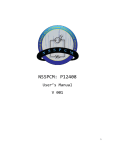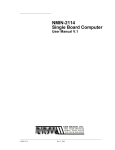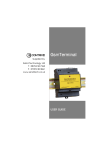Download NMIN-2107 Single Board Computer
Transcript
NMIN-2107 Single Board Computer User Manual V.2 NMIN-2107 Nov 21, 2001 Table of Contents Overview . . . . . . . . . . . . . . . . . . . . . . . . . . . . . . . . . . . . . . . . . . . . . . . Included Files . . . . . . . . . . . . . . . . . . . . . . . . . . . . . . . . . . . . . . . . . 2 2 Getting Started . . . . . . . . . . . . . . . . . . . . . . . . . . . . . . . . . . . . . . . . . . 3 Memory Map . . . . . . . . . . . . . . . . . . . . . . . . . . . . . . . . . . . . . . . . . . . . 4 Programming the Board . . . . . . . . . . . . . . . . . . . . . . . . . . . . . . . . . . ONCE Connector and Parallel Port . . . . . . . . . . . . . . . . . . . . . . . . Modified S-Records and Serial Port . . . . . . . . . . . . . . . . . . . . . . . . Transforming S-Records . . . . . . . . . . . . . . . . . . . . . . . . . . . . . . . . . Hooking Into Autoboot . . . . . . . . . . . . . . . . . . . . . . . . . . . . . . . . . . On-board Development System . . . . . . . . . . . . . . . . . . . . . . . . . . . 4 4 5 5 6 6 I/O Connections and Jumpers:. . . . . . . . . . . . . . . . . . . . . . . . . . . . . Components . . . . . . . . . . . . . . . . . . . . . . . . . . . . . . . . . . . . . . . . . . 6 7 Board Layout . . . . . . . . . . . . . . . . . . . . . . . . . . . . . . . . . . . . . . . . . . . 8 Schematic . . . . . . . . . . . . . . . . . . . . . . . . . . . . . . . . . . . . . . . . . . . . . . 9 Examples . . . . . . . . . . . . . . . . . . . . . . . . . . . . . . . . . . . . . . . . . . . . . . Reading from the A/D port . . . . . . . . . . . . . . . . . . . . . . . . . . . . . . . 10 10 User Manual V.2 Nov 21, 2001 1 Overview The NMIN-2107 single computer board provides you with plug and play access to the powerful 32 bit Motorola MMC2107 microcontroller. The computer board provides power regulation, RS232 and RS422 serial support and an LCD connector. The microcontroller includes the following built in capabilities: port A ONCE A/D port E port B MMC2107 Microcontroller SPI interrupts port C port D • • • • • • • • • • • • • timer SCI MCORE 32-bit RISC low-power integer processor 128K of block programmable (16K) flash memory 8K of static RAM 8 channels of 10-bit A/D with queueing 2 asynchronous serial channels 1 synchronous serial channel 8 timer channels with PWM capability up to 40 interrupts periodic interval timer watchdog timer 35 digital I/O pins eight external interrupts ONCE debug support The computer board’s power consumption with RS-422 drivers installed is about 80mA. Included Files The following files are included and are available from our website. The MaxForth file is only available if you have licensed it. • sloader.s - serial boot loader file in s-record format that can be downloaded through the ONCE port • sloader.sp - serial bootloader file in modified s-record format that can be downloaded through the serial port • sikadown.pl - the Perl script used to modify s-records for downloading through the serial port and the serial loader • nmin2107.pdf - this manual in PDF format • mfcoreapp.s - MaxForth in s-record format • mfcoreapp.sp - MaxForth in modified s-record format User Manual V.2 Nov 21, 2001 2 Getting Started Computer Board MMC2107 (Sika) Flash Programmer : Power Serial Cable You will interact with your board by connecting it to a PC using a serial cable and running a terminal program such as HyperTerminal or an equivalent setup. You need to set it to 19200 BAUD, one stop bit, no parity and 8 data bits. Connect an RS232 serial cable between your PC’s COM port and the serial port on the board. To power up the board, you need a 9 to 12 volt plug in transformer plugged into the power jack, PJ1 (AC, DC both polarities accepted). When everything is ready and you plug in the power, you should receive a prompt in the terminal program. MMC2107 (Sika) Flash Programmer : or Max-FORTH V5.0N (license agreement is required) And when you depress the ENTER key, it should also response with type ? for help : or OK (Max-FORTH prompt) WHen you see that message, it means the communication is established and you are ready to interact with the board and microcontroller. By pressing the reset button, SW1, you should get the same boot prompt as when you powered it up. Pressing the reset button will leave the contents of most of the RAM intact which might be useful for debugging purposes, whereas, if you power cycle the board, then all RAM contents will be lost. User Manual V.2 Nov 21, 2001 3 Memory Map The memory map consists of the RAM, ROM and registers. The interrupt vectors can exist anywhere by setting the vector base register (VBR). 0xFFFF.FFFF External Memory 0x8000.0000 Registers 0x00C0.0000 0x0080.1FFF 0x0080.0000 0x0001.FFFF 0x0000.4000 0 ports Internal RAM 8K serial loader Internal Flash 128K MaxForth or Application boot loader Programming the Board There are several ways in which to program the board: 1. 2. 3. download an s-record through the ONCE connector and the PC parallel port with CPROGMCZ download a modified s-record using the embedded bootloader and a serial port with HyperTerminal interact directly with the microcontroller and download source code to the on-board development system, MaxForth, through a serial port and HyperTerminal ONCE Connector and Parallel Port Using the MCORE Cable from P&E Micro or equivalent, plug it into the parallel port of your computer through a parallel port cable and the ONCE port on the computer board making sure to orientate the triangle on the pin header to pin 1 on the board which is marked by a square solder pad on the bottom of the board. Apply power to the board. When disconnecting from the board make sure it goes through a power cycle before you try out the downloaded software as a reset is not enough to regain control of the microcontroller after interacting with the ONCE port. If you already have CPROGMCZ running, click reset the chip. If you start it up, it will reset the chip and proceed to the next choice which is to read in a configuration file. The file that works with the board is the MMC2107K_1.MCP file which should be in the directory for configuration files. Next you will need to erase the module, specify an s-record to download and then program the module. To test out the software, you must disconnect the ONCE connector and power cycle the board. The serial bootloader User Manual V.2 Nov 21, 2001 4 file can be downloaded and then used to program the flash ROM using the serial port as described next. Check the help screens for more details. Modified S-Records and Serial Port Using the serial bootloader, you can download s-records that have been created by a C compiler or assembler system that you have acquired separately, to flash memory to be run. The help menu, invoked by typing a ?, is: : ? To download to flash: 1. bulk erase if necessary 2. Make sure the delay time between lines is set to at least 75 ms 3. Type f 4. Send S-record (processed with perl script "sikadown.pl") as a text file f - Program flash v - Verify flash b - bulk erase all of the flash e - erase application from flash : When programming the flash with an s-record, the locations to be programmed should be erased to 0xFF first by either erasing the whole flash or just all the sectors but the first one which contains the serial bootloader. WARNING If you do bulk erase the entire flash with the ‘b’ selection, then the serial boot loader will be gone and you will not be able to reboot. Your application should either put a vector at location 0000, or you should download the serial bootloader program (sloader.sp). The serial bootloader works by running out of RAM. At bootup, the startup program in flash checks to see if there is an application at location 0x4000 by checking for a vector (anything but 0xFFFFFFFF). If there isn’t, then it copies the serial bootloader program from flash to RAM and then runs the program. The serial bootloader program must run out of RAM to be able to program flash memory. If you erase all of flash, then the next time you reset the board, there will be no programs present and you will have to program it through the ONCE port. Otherwise if you download a program with a reset vector at location 0x00000000, such as the serial bootloader program, then it will boot up next time. You have the flexibility to keep the serial bootloader program as part of your end system or to remove it and replace it with another program. Any s-records that you do download to the board must be transformed by the perl script, sikadown.pl. Quick Tip !! If you are using the serial boot loader to test out your application which starts with a vector at location 0x4000, then just use ‘e’ and ‘f’ to download your application. If you download an application, reboot and nothing happens, you can recover to the serial boot loader by shorting out PA7 to +3V on the J2 connector with a jumper or equivelant and pressing the reset button. You will be taken back to the serial bootloader where you can erase your errant application and try again. Transforming S-Records To run the Perl script to transform your s-records into the required format for the serial downloader, you will need to have Perl installed on your computer. You can get a copy of perl for your Windows, Linux or Solaris platform from: http://www.activestate.com/Products/ActivePerl/download.plex User Manual V.2 Nov 21, 2001 5 To transform an s-record, you can type in the following commands in a DOS command window assuming that Perl is installed and the script is running in the current directory: \perl\bin\perl sikadown.pl sloader.s sloader.sp The format of the command is Perl followed by the Perl script, then by the s-record file and finally by the name of the transformed output file. NOTE If you include different memory regions in your code, make sure that your memory regions are 64 bytes or bigger as the perl script will mess up the translation from the S19 file to the massaged s19 file. Compare the two if in doubt. Hooking Into Autoboot You can autoboot your application by leaving a vector to it at location 0x4000. The startup boot loader will detect this vector and then jump to the location that the vector is pointing to. When MaxForth is installed, it has a vector at that location. To get to the serial loader from MaxForth, type in FLASH and enter. To get back to the serial loader from an application, execute the vector stored at location 0x190 in memory. The application area, 0x0.4000-0x1.FFFF can be erased using the serial loader without the boot loader being removed from memory. On-board Development System Taking advantage of the interactive nature of the board’s development system, MaxForth, you can interact directly with the microcontroller’s peripherals by fetching and storing values to the configuration registers for the peripheral devices. This is an effective way of understanding the peripheral documentation, to verify correct initialization sequences, running some tests on different configurations and debugging driver code as you develop it. By typing in new definitions, you can add new macros to the dictionary for interactive use or for creating an automated program. Some examples are given later on. I/O Connections and Jumpers: • • • • • • • • • • • • • • • • J1, LCD connector, match the triangle on the connector with the pin with a square solder pad. J2, J3, J4 are general purpose I/O connectors including timers, A/D, INT, etc. J5, RESET & GND pin not installed. It may be used as option for a front panel mounted reset switch. J6, Misc. signals J7, JTAG/Once J8, includes jumper A, B, C. The Jumpers A,B,C allow both RS-232 drivers for COM1 & COM2 or 1 RS232 and 1 RS-422 driver for either COM. Jumper A allows RS-422 selection of either TxD1 or TxD2 of SCI0 or SCI1 serial output signals respectively. Jumper B is the serial input to SCI1 labeled RxD2; it is defaulted to RS-232 but can be jumpered the other way for RS-422. (Next to Jumper B is +5V & GND. This can be used for a test point or external 5V source to power a probe. Use a paper separator for protection.) Jumper C is the serial input to SCI0 labeled RxD1. It is defaulted to RS-232 but can be jumpered for other way for RS-422. J9, Flash voltage supply. Connects when flash needs to Erase/Program. Open when flash does not need to erase/program or for Write protection. J10, serial connection for SCI1. DB1, serial connection for SCI0. J12, RS-232 shut down control input. Drive high for normal operation. Drive low to shut down the drivers. This can be controlled by PA2 or jumper to 3V for normal operation (default). J13, RS-422 connector J14, Jumper to GND (default) for RS-422 receiver always or jumper to PA6 as RS-485 transmitter/ Receiver control signal. J15 connects to pin 1 of RS-232, U2. This pin can be used to enable/disable the receivers for the RS- User Manual V.2 Nov 21, 2001 6 232 interface. For normal operation, this pin must be low. By default, J15 is open and this pin is pulled down through R5. To disable the receivers, J15 can be connected and controlled via PA0. Set it high to disable and low to enable the receivers. • J16 is only needed when U2, the RS-232 chip, is not installed and the LCD application required. Do not connect J16 if U2 is present. This can damage U2. Components • SW1, reset switch • RP1, 10K resistor pot for LCD contrast adjustment. • U3, MAX4628 is the analog switch that provides the 5V to the flash VPP pin & A/D power source. This allows the CPU to power up before the flash gets power and down after the power cuts off from the flash to protect the flash from damage. User Manual V.2 Nov 21, 2001 7 Board Layout 6 9 1 5 R7 R6 CR1 J15 J14 J13 U4 U5 C11 VR1 C10 C13 1 J10 C17 R5 C12 C14 U2 C15 A C16 C9 B RxD2 +5V GND J9 1 C R4 C7 U3 Q2 D1 J16 J7 1 V- SW1 VR2 C8 J8 C6 L2 1 J6 GND 1 1 GND +3V PA6 PA7 PA4 PA5 PA2 PA3 PA0 PA1 PB6 PB7 C5 RN1 R3 1 L1 C3 C4 VRH C1 R2 C2 PQA0 PQ PQA3 PQ PQB0 PQ RN2PQB2 PQ 1 PE5 PE PE7 SS ST J5 Q1 RP1 J1 U1 1 VR PB4 PB5 PB2 PB3 SCK PB0 PB1 MISO MO PC6 PC7 INT7 INT PC4 PC5 INT5 INT PC2 PA3 INT3 INT PC0 PC1 INT1 INT R1 1 J2 R0 J4 1 J3 User Manual V.2 Nov 21, 2001 8 User Manual V.2 Nov 21, 2001 A B C D J10 8 U2 DB1 3.3V 14 R7 13 10 5 6 19 15 12 3 7 20 PA2 PA0 C25,C28,C29 0.1UF +5V J12 A 3.3V PA6 8 7 6 5 C B 3.3V R6 0.1UF 7 C24-C27,C31,C32 Q2 S80730AN 3.3V J8 C14 C15 +3.3V RxD2 TxD1 TxD2 RxD1 C16 3.3V J14 1 2 3 MAX3483 4 U5 J13 7 C18,C20,C21,C22 AdditionalBypassCapacitors GND DTR TX RX NC 8 9 16 17 4 C13 2 1 18 J15 6 7 8 9 1 2 3 4 5 R5 10K 0.1UF +5V NC NC CTS RTS DSR U4 8 2 7 3MAX3483 6 4 5 1 C19,C23 3.3V 8 10K R4 3.3V RxD1 +5V 1 +5V RxD2 6 MAX4628 U3 +5V VDD VDDF VDD TXD1 TXD2 ICOC10 ICOC12 ICOC20 ICOC22 PD0 PD2 PD4 PD6 GND PA6 PA4 PA2 PA0 PB6 PB4 PB2 PB0 PC6 PC4 PC2 PC0 +5V 3.3V R3 10K 3.3V 1 3.3V PJ1 J9 VPP CR1 5 R1 5 VM08/DB101 V- RP1 10K +5V +5V J16 .1uF VSSA C5 VDDA 9-12V L1 10uH 10uH L2 VSS VSSF RXD1 RXD2 TEST ICOC11 ICOC13 ICOC21 ICOC23 PD1 PD3 PD5 PD7 PA7 PA5 PA3 PA1 PB7 PB5 PB3 PB1 PC7 PC5 PC3 PC1 VSS J3 J2 LCDCONNECTOR J1 PA7 NC PB7 PB6 PB5 PB4 PB3 PB2 PB1 PB0 PA3 PA5 PA1 VO NOTE:DonotconnectJ16ifU2isinstalled 6 100uF C11 VPP 10K PA6 1 PA5 2 PA4 3 PA3 4 PA2 5 PA1 6 PA0 7 PB7 8 PB6 9 PB5 10 PB4 11 VSS 12 VDD 13 PB3 14 PB2 15 PB1 16 PB0 17 PC7 18 PC6 19 PC5 20 VSS 21 VDD 22 PC4 23 PC3 24 PC2 25 PC1 26 PC0 27 PD7 28 PD6 29 PD5 30 PD4 31 PD3 32 PD2 33 PD1 34 PD0 35 ICOC23 36 ICOC22 37 ICOC21 38 ICOC20 38 ICOC13 40 ICOC12 41 ICOC11 42 ICOC10 43 TEST 44 TXD2 45 RXD2 46 TXD1 47 RXD1 48 INT0 49 INT1 50 IN OUT GND 4 PA7 DE TRST VDD VSS TMS TDO TDI TCLK VDD CLKOUT VSS VSSSYN EXTAL XTAL VDDSYN RSTOUT RESET VDDA VSSA VRH VRL PQA0 PQA1 PQA3 PQA4 PQB0 PQB1 PQB2 PQB3 VDDH PE5 PE6 PE7 SS SCK VSTBY MISO MISI INT7 INT6 VPP INT5 INT4 INT3 VDD VSS INT2 VDDF VSSF VR1 51 52 53 54 55 56 57 58 59 60 61 62 63 64 65 66 67 68 69 70 71 72 73 74 75 76 77 78 79 80 81 82 83 84 85 86 87 88 89 90 91 92 93 94 95 96 97 98 99 100 LM78L05 .1uF C10 U1 4 D1 C9 .1uF C8 3.3V 3.3V 1N5817 100uF +5V VDDA 1 3 IN 1 5 1 6 1 2 1 7 3 RP1 C6 3.3V 10Kx7 100uF 1 8 1 C1 2 22PF 10M 1 C2 2 22PF R2 LM3940 OUT GND 1 4 XTAL1 2 1 VSSSYN RSTOUT VSSA VSSH 8Mhz J6 VR2 1 RP2 2 VDDSYN CLKOUT 1 VDDA VDDH 3 .1uF C7 3.3V R0 10K 3.3V 2 3 4 5 6 7 8 1 1 1 1 1 1 1 3.3V FINISH 2 C.N. T.N. APPROVALS CHECKED DRAWN J7 2 GND GND GND NC TMS DE TRST 110601 110601 DATE VDDA VRH PQA0 PQA3 PQB0 PQB2 PE5 PE7 SCLK MISO INT7 INT5 INT3 INT1 SCALE D SIZE TITLE J4 VSSA VRL PQA1 PQA4 PQB1 PQB3 PE6 SS VSTB MOSI INT6 INT4 INT2 INT0 JTAG/OnCE 1 TDI TDO TCLK GPIO/SI RESET VDD GPIO/SO SW1 NewMicros,Inc. 1601ChalkHillRd. Dallas,TX.75212 www.newmicros.com 3.3V 10Kx7 2 3 DWGNO. 1 1SHEET 1OF1 01 REV J5 optional .001 C4 Q1 BBG06 NMIN-2107 MCORECPU 2 S80728AN 3.3V 1 A B C D Schematic 9 Examples These examples may be typed in interactively or cut and pasted into the terminal window if you are using MaxForth. Otherwise they can be translated to the language that you are using to program the microcontroller with. Reading from the A/D port For this example we will consider the simplest way to get an A/D reading: get A/D reading initialize A/D request channel 0 channel 0? not yet display reading Done. This involves: setting up the A/D registers so it is ready to go; requesting a read of a channel; waiting for that channel to complete converting; and finally reading and displaying the value. Each of these boxes on the diagram will become a word except for Done. HEX : H@ ( a -- h ) : DISPLAY-READING : CHANNEL0? : CLEAR0 ( -- ) ( -- f ) ( -- ) : REQUEST0 ( -- ) : INIT-A/D ( -- ) : GETAD COUNT 100 * INIT-A/D SWAP C@ OR ; CA0280 H@ . ; CA0010 C@ 80 AND ; CHANNEL0? CLEAR0 IF 2 CA0200 C! REQUEST0 CA0010 DUP C@ 80 NOT AND SWAP C! THEN ; 21 CA000C C! ; C0 CA0201 C! BEGIN CHANNEL0? 2 CA0202 C! UNTIL FF CA0203 C! ; DISPLAY-READING ; The first reading is from 5 volts, the second from 0 volts and the third from 3.3 volts all applied to pin PQB0 on connector J4. GETAD 3D0 GETAD 21 GETAD 2A4 User Manual V.2 OK OK OK Nov 21, 2001 10
















